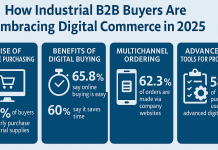B2B companies depend heavily on data to drive operations, decisions, and customer experiences. Traditional pipelines, however, often struggle with inefficiencies such as delayed data access, siloed sources, and high ETL maintenance.
Data virtualization is emerging as a modern solution that simplifies how B2B enterprises access and integrate data without replicating or moving it.
What Is Data Virtualization
Data virtualization is a data integration approach that connects and delivers data from various sources through a single virtual layer. It allows users to access real-time data without extracting, transforming, or loading it into a separate storage system.
Instead of duplicating data or building complex data pipelines, data virtualization connects directly to live systems and provides unified access across platforms such as ERP, CRM, cloud services, and databases.
Why Data Virtualization Matters in B2B
Real-Time Access to Business Data
B2B operations rely on multiple platforms across the supply chain, sales, finance, and customer management. Data virtualization enables instant access to live data across these systems, enhancing responsiveness and decision-making.
Example: A logistics firm can view inventory, shipments, and delivery timelines in one place by linking multiple backend systems without moving the data.
Faster Insights Without Data Duplication
Analytics teams gain faster access to unified reports without waiting for daily or weekly batch jobs. Reports based on virtualized data are always up to date, reducing lag between data collection and decision-making.
This improves operational planning, campaign timing, and customer engagement by using the most recent available information.
Simplified ETL Process
Traditional ETL processes are time-consuming and resource-heavy. Data virtualization reduces or eliminates the need for these pipelines by allowing transformations during query execution.
This streamlines the reporting workflow, frees up engineering resources, and lowers infrastructure costs.
Core Benefits of Data Virtualization for B2B
Unified View: Combines data from multiple systems in a single interface.
Reduced Costs: Eliminates duplicate storage and lowers integration expenses.
Faster Reporting: Enables live dashboards and ad hoc queries.
Better Governance: Central control with no physical data movement.
Easier Partner Access: Connects external sources securely without full migration.
Key Use Cases in B2B Operations
- Supply Chain Visibility: Aggregate data from manufacturers, vendors, and distributors to monitor operations in real time.
- Customer Intelligence: Merge CRM, support, and billing data to build unified customer profiles.
- Compliance Reporting: Access financial or audit data instantly for regulatory needs without waiting for batch updates.
Challenges and Considerations
Data virtualization may face performance issues when processing large volumes of unindexed data across multiple sources. Some legacy systems also require custom connectors or APIs to integrate properly.
Choosing a platform with strong governance, caching, and security capabilities is essential for scalability and compliance in B2B environments.
Is Your B2B Team Ready for Data Virtualization
For B2B companies facing delays in reporting, scattered data sources, or high ETL maintenance costs, data virtualization offers a direct path to more efficient data management.
It enables real-time insights, lowers IT overhead, and improves agility without the need for large-scale infrastructure changes.
By adopting data virtualization, B2B enterprises can gain faster decision-making capabilities, better collaboration between teams, and a scalable data strategy that supports long-term growth.










